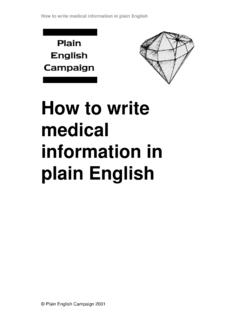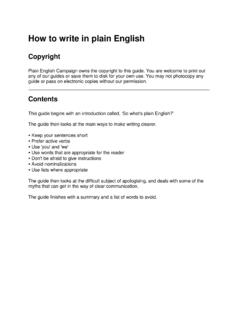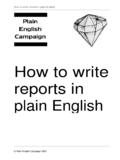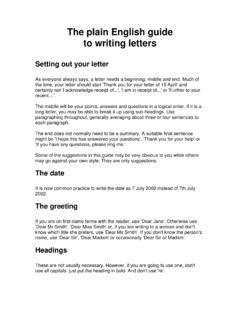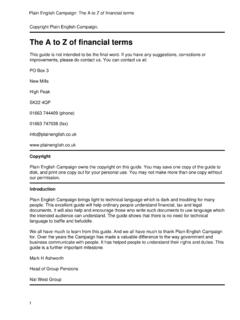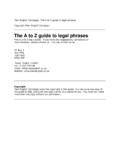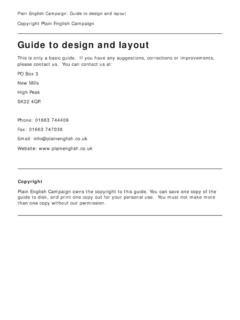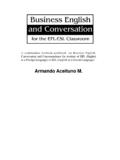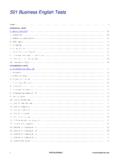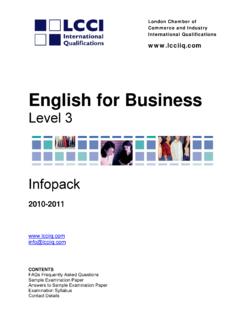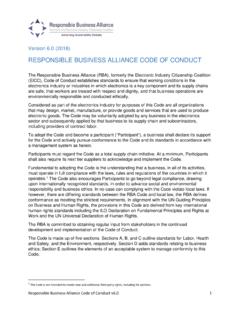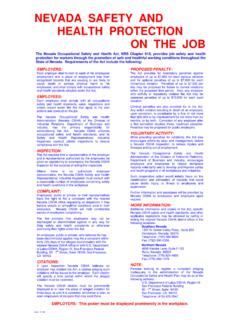Transcription of Writing business emails - Plain English Campaign
1 ! " # $ % & ' ()** +, " 0+++-1 2 ! " 0+0-"3 4 ' $$$ ' $ 5 ' 5 ' $ Introduction email has changed the way we work allowing us to communicate cheaply and quickly with colleagues, suppliers and other contacts around the world. Many of us now use it as our main means of communication during the working day. But what are the best techniques to use when Writing emails ? Are the rules for Writing emails different to those we have already learned? emails are written communications, and their purpose, generally, is to send information. If we relax the rules of grammar and clear communication, we will fail to get our message across.
2 So it is important to stick to the usual guidelines. However, emails are normally less formal than a printed business letter. Etiquette There is still some confusion about the correct way to write emails , which 'tone' is appropriate, and whether to use slang or abbreviations. It is best to open and close an email using 'Dear' at the beginning and 'Best wishes' or 'Regards' at the end. 'Hi' is not really appropriate for business emails unless you are familiar with the person you are Writing to. If you do not know the person's full name, use the person's title (for example 'Dear Director of Customer Services').
3 Always think about the reader. Remember that people are unlikely to be offended if you are too formal, but some may think you are being rude if you are too informal. Spelling and grammar You should always write emails with the same care you would use to write a formal letter. Always check your spelling and grammar most email applications have a tool which you can use to do this automatically. Remember that sloppy communication gives a bad impression of both you and your organisation. Resist the temptation to use the shortcuts of 'text messaging'. While some people may understand what 'cant w8 2 cu' means, a lot of people do not.
4 Addressing an email To this is where you type the email address of the person you are Writing to. CC (courtesy copy) this is for the email addresses of other people who need to see the information in your email . BCC (blind courtesy copy) addresses that you put in this field are 'hidden' from the other people who receive the message. For example, if you wrote an email to your insurance company but wanted a solicitor to read it for reference without the insurers knowing, you would use this field for the solicitor's address. Always use the correct field so people know who you expect to act first on the information.
5 email examples Here are two email examples. The first contains all the worst aspects of a bad business email . The second shows you a good example template you might want to bear in mind when Writing your business email . How not to write a business email Whatever you do, don t do Dude! I m just wondering about a possible meeting being set up. What it is, don t worry about it, but could we, like, arrange something maybe? No rush! Hey did you see Eastenders the other night? I love it, it s AMAZING. Anyway, yeah, cool. Speak soon, if you want. Don t worry if not.
6 Cheers! Dx The opening is clearly too informal and impersonal if you don t know the name of the recipient use To whom it may concern or Dear Sir/Madam . However, if you do know the name of the recipient, use it. Dear Name as by not doing so you ll seem ignorant. After all, you re meant to be building a professional relationship with the person in question. The opening paragraph is too casual, informal and unprofessional. And, crucially, there s no thank you for responding to the initial email . The second paragraph is a poor attempt at adding a personal touch.
7 As long as you re professional, courteous and polite, there s no need to throw anything like this in. Yes, it s email , not a letter but there is no reason or excuse for letting standards drop, or giving the wrong impression. The third paragraph is far too casual and indecisive, leaves too much room for doubt, and suggests someone easily placated and generally not all that bothered. And emoticons are a definite no-no. Cheers! is best avoided, unless you ve already developed a long-term relationship with the recipient. Even then, it s not ideal in a business capacity.
8 Finally, always finish with both your full first name (at least) and a proper sign-off. This is far too casual and is what you might expect to see in a text message. You must remember that it s incredibly easy to slip into bad habits. Always write as though to a managing director because, until you know otherwise, you might be! How to write a business email Far better to follow this Dear Stephen I hope you are well. It was great to hear from you thank you for your time. Could we set up a meeting on this? Let me know when s best for you and we can arrange something.
9 It d be great to discuss this in person, rather than by email . If you have any further questions on this, don t hesitate to ask. I look forward to speaking to you again. Kind regards David Key points to remember Be concise. Remember that some people receive and read hundreds of emails every day. Try to keep to a maximum length of five paragraphs. If your message is very long (for example, notes about a report) consider sending it as an attachment. Don t use an inappropriate email address from which to send your email (such as If you do not have a business email address, set one up using your name or your company name.)
10 Make sure you title your email clearly in the subject box as this helps the reader to refer to your email at a later date. Try to keep titles short. Use ' Plain -text' for your formatting rather than HTML (which creates web-page-style emails ). This will mean that everyone reading your email will see it as you intended. Bear in mind that not everyone uses a computer to access their email , and people may be using a device that can only display text. Use bulleted lists and keep paragraphs short. If you are Writing to someone for the first time, structure your email as you would a letter, with a beginning, a middle and an end.
